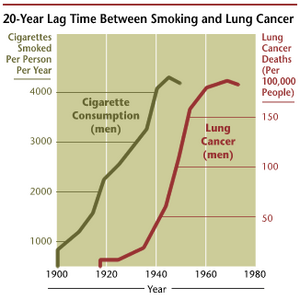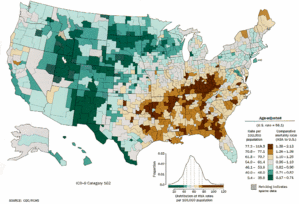COPD and lung cancer loom as two of our greatest challenges in pulmonary medicine. Both are smoking-related diseases that cluster in families ant] worsen with age. COPD and lung cancer are often related to smoking and/or various occupational exposures), (1,2) but this remarkable association remains vet to t)e better studied and explained.
The pathogenesis of COPD is currently being understood through intense studies originating from many laboratories. (3) Mechanisms in the pathogenesis of lung cancer are also being aggressively approached concurrently. Are these really two diseases or two manifestations of the same disease with genetic predisposition, smoking, and environmental exposures as common denominators? This commentary explores the pathogenesis of COPD and lung cancer and considers common factors in the association between these two rising killers.
Considering their relationship, we might consider both COPD and lung cancer as genetically determined diseases (3) that create a predisposition for personal and environmental insults that result in clinical expressions of both diseases. Smoking and occupational toxins, as well as community air pollution, may impose a series of' accumulated and damaging mutations that ultimately inflame and destroy airways alveoli and also induce dysplastic and ultimately neoplastic changes in the lungs of patients with COPD and lung cancer. The exact mechanisms by which lung inflammation occurs and dysplastic changes are induced continue to be explored, and new theories are evolving.
In contrast to alveolar inflammation in the spectrum of interstitial lung diseases, alveolar damage in emphysema is apparently not a result of alveolitis. No fibrosis occurs in uncomplicated emphysema. Studies from Kasahara et al (4,5) indicate that loss of alveolar walls is a consequence of loss of capillaries from reduced vascular endothelial growth factor (VEGF). The pulmonary capillary bed is comprised of the alveolar nutrient vessels. (4,5) As capillaries drop out through accelerated apoptosis, so do alveolar walls. Thus, while the airway lesions are inflammatory in nature, the alveolar lesions might best be conceptualized as ischemic.
In moderate stages of COPD, VEGF may be involved in adverse pulmonary vascular responses resulting in pulmonary hypertension. However, in advanced emphysema, VEGF was found to be reduced in tissues obtained at resection for lung cancer or for lung volume reduction surgery. (6)
Beyond the study of genetic background factors and environmental provocations and their resultant lesions, it is important to consider COPD as a systemic disease. (7) Specific questions to be answered are why do individuals with only mild-to-moderate COPD have impaired exercise tolerance and inability to achieve a targeted heart rate, as well as failure to achieve targeted oxygen uptake? Could this exercise impairment already be due to emerging pulmonary hypertension and right ventricular afterload in mild-to-moderate COPD? (8) Mild-to-moderate COPD is usually not associated with hypoxemia, so perhaps other mechanisms are involved. (9)
Since oxygen uptake indicates the sum of metabolic activities at the tissue level, these observations suggest impaired oxygen utilization. Perhaps poor oxygen utilization may be caused by inflammatory cytokines involved in COPD, and perhaps lung cancer that somehow are toxic to mitochondria and their ability to create energy through the metabolism of foodstuffs made possible by oxygen. (7) The body wasting with weight loss and skeletal muscle atrophy are further manifestations of the systemic nature of COPD, but the mechanisms are unknown. (8) Muscle wasting is common in symptomatic stages of lung cancer.
Centrilobular emphysema is primarily an upper-lobe destructive process. Why does lung cancer locate in the apices in smoking-related centrilobular emphysema? One hypothesis is that it may be due to the relative hypoxia of the apices. It is known that there are hypoxia-related genes that may promote angiogenesis. (10,11) Evidence suggests that angiogenic dysplasia is a prelude to invasive carcinoma. (12) Is VEGF the cause of angiogenic dysplasia that appears to be a precancerous lesion? (12)
Today we need expanded research in both COPD and lung cancer, but we also need applied clinical research programs to improve patients now. The National Lung Health Education Program (NLHEP), as well as the Global Initiative in Chronic Obstructive Lung Disease (GOLD), promote the early identification and intervention in COPD and related disorders. The NLHEP has stimulated the production of simply new practical office spirometers, which have been validated in field testing. (13,14) The NLHEP recommends that all smokers, both current and former [greater than or equal to] 45 years old, should have simple spirometric testing. (13) The GOLD classifies early abnormality as an [FEV.sub.1]/FVC ratio of < 70%, even with a normal absolute [FEV.sub.1] percentage of predicted [greater than or equal to] 80%. (14) The NLHEP recommends using the forced expiratory volume in 6 s as a surrogate for FVC. (13,14)
What about steroids in COPD and in lung cancer? Controlled clinical trials do not show a reduction in the decline of [FEV.sub.1]. (15-18) Other studies (19) suggest a reduction in fall of [FEV.sub.1] and even the possibility of reduced mortality is associated with the use of inhaled corticosteroids in COPD. Could budesonide also be effective in the chemoprevention of lung cancer? (20) Can steroids and Cox-2 inhibitors be used in the chemoprevention of lung cancer? (21)
Can industry produce a well-tolerated bronchodilator that can retard the rate of decline of [FEV.sub.1] in COPD? Ipratropium was effective in the Lung Health Study (22) throughout 5 years of observation, but it did not slow the rate of decline of [FEV.sub.1]. Perhaps the newly introduced anticholinergic, tiotropium, may be more effective in both physiologic improvement and control of symptoms, (23) and in slowing of [FEV.sub.1] decline over time. The slowing of lung function decline could also be a favorable factor in lung cancer prevention.
In summary, huge challenges in COPD and lung cancer exists for basic scientists applied scientists and clinicians. These can only be solved by well-organized and orchestrated collaborative efforts.
REFERENCES
(1) Sanford AJ, Weir TD, Pare PD. Genetic risk factors for chronic obstructive pulmonary disease. Eur Respir J 1997; 10:1380-1391
(2) Bromen K, Pohlabeln H, Jahn I, et al. Aggregation of lung cancer in families: results from a population-based case-control study in Germany. Am J Epidemiol 2000; 152:497-505
(3) Barnes PJ, Shapiro SD, Pauwels RA. Chronic obstructive pulmonary disease: molecular and cellular mechanisms. Eur Respir J 2003; 22:672-688
(4) Kasahara Y, Tuder RM, Taraseviciene-Stewart L, et al. Inhibition on VEGF receptors causes lung cell apoptosis and emphysema. J Clin Invest 2000; 106:1311-1319
(5) Kasahara Y, Tuder RM, Cool CD, et al. Endothelial cell death and decreased expression of vascular endothelial growth factor and vascular endothelial growth factor receptor 2 in emphysema. Am J Respir Crit Care Med 2001; 163:737-744
(6) Santos S, Peinado VI, Ramirez J, et al. Enhanced expression of vascular endothelial growth factor in pulmonary arteries of smokers and patients with moderate COPD. Am J Respir Crit Care Med 2003; 167:1250-1256
(7) Schols AM, Buurman WA, Staal van den Brekel AJ, et al. Evidence for a relation between metabolic derangements and increased levels of inflammatory mediators in a subgroup of patients with chronic obstructive pulmonary disease. Thorax 1996; 51:819-824
(8) Schols AM, Slangen J, Volovics L, et al. Weight loss is a reversible factor in the prognosis of chronic obstructive pulmonary disease. Am J Respir Crit Care Med 1998; 157: 1791-1797
(9) Carter R, Nicrota B, Blevins W, et al. Altered exercise gas exchange and cardiac function in patients with mild chronic obstructive pulmonary disease. Chest 1993; 103:745-750
(10) O'Farrell PH. Conserved responses to oxygen deprivation. J Clin Invest 2001; 107:671-674
(11) Maxwell PH, Weisener MS, Chang G, et al. The tumour suppression protein VHL targets hypoxia-inducible factors for oxygen-dependent proteolysis. Nature 1999; 399:271-275
(12) Keith RL, Miller YE, Gemmill RM, et al. Angiogenic squamous dysplasia in bronchi of individuals at high risk for lung cancer. Clin Cancer Res 2000; 5:1616-1625
(13) Ferguson GT, Enright PL, Buist AS, et al. Office spirometry for lung health assessment in adults: a consensus statement from the National Lung Health Education Program. Chest 2000; 117:1146-1161
(14) Pauwels RA, Buist AS, Calverley PM, et al. Global strategy for the diagnosis, management, and prevention of chronic obstructive pulmonary disease: NHLBI/WHO Global Initiative for Chronic Obstructive Lung Disease (GOLD) Workshop Summary. Am J Respir Crit Care Med 2001; 163:1256-1276
(15) Vestbo J, Sorensen T, Lange P, et al. Long-term effect of inhaled budesonide in mild and moderate chronic obstructive pulmonary disease: a randomised controlled trial. Lancet 1999; 353:1819-1823
(16) Pauwels RA, Lofdahl CG, Laitinen LA, et al. Long-term treatment with inhaled budesonide in persons with mild chronic obstructive pulmonary disease who continue smoking: European Respiratory Society study on chronic obstructive pulmonary disease. N Engl J Med 1999; 340:1948-1953
(17) Burge PS, Calverley PM, Jones PW, et al. Randomized, double blind, placebo controlled study of fluticasone propionate in patients with moderate to severe chronic obstructive pulmonary disease: the ISOLDE trial. BMJ 2000; 320:1297-1303
(18) The Lung Health Study: effect of inhaled triamcinolone on the decline in pulmonary function in chronic obstructive lung disease. N Engl J Med 2000; 343:1902-1909
(19) Soriano JB, Vestbo J, Pride NB, et al. Survival in COPD patients after regular use of fluticasone and salmeterol in general practice. Eur Respir J 2002; 20:819-825
(20) Wattenberg LW, Wiedmann TS, Estensen RD, et al. Chemoprevention of pulmonary carcinogenesis by brief exposures to aerosolized budesonide or beclomethasone dipropionate and by the combination of aerosolized budesonide and dietary myoinositol. Carcinogenesis 2000; 21:179-182
(21) Masferrer J. Approach to angiogenesis inhalation based on cyclooxygenase 2. Cancer J 2001; 7(Supp1):5144-5150
(22) Anthonisen NR, Connett JE, Kiley JP, et al. Effects of smoking intervention and the use of an inhaled anticholinergic bronchodilator on the rate of decline of [FEV.sub.1]: the Lung Health Study. JAMA 1994; 272:1497-1505
(23) Tashkin D, Kersten S. Long-term treatment and benefits with tiotropium in COPD patients with and without short-term bronchodilator responses. Chest 2003; 123:1445-1449
Thomas L. Petty, MD, Master FCCP
Snowdrift Pulmonary Conference
Denver, Co
Correspondence to: Thomas L. Petty, MD, Master FCCP, Professor of Medicine, University of Colorado, 899 Logan St, Suite 203, Denver, CO 80203; e-mail: tlpdoc@aol.com
* Based on the Keynote Speech, Lovelace Respiratory Research Institute, Annual Scientific Meeting, Santa Fe, NM, October 10, 2003.
COPYRIGHT 2005 American College of Chest Physicians
COPYRIGHT 2005 Gale Group



